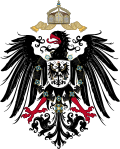This article needs additional citations for verification .(February 2022) |
| Order of Merit of the Bavarian Crown Verdienstorden der Bayerischen Krone | |
|---|---|
 Star and sash of the order | |
| Awarded for | Merit deserving the recognition of the state |
| Country | |
| Presented by | the King of Bavaria |
| Eligibility | Civil servants, non-nobles, and foreigners |
| Motto | virtus et honor |
| Status | No longer awarded |
| Established | 19 March 1808 |
 | |
| Precedence | |
| Next (higher) | Military Order of Max Joseph (Militär-Max-Joseph-Orden) |
| Next (lower) | Order of St. Michael |
The Order of Merit of the Bavarian Crown (German : Verdienstorden der Bayerischen Krone) was an order of merit of the Kingdom of Bavaria established by King Maximilian Joseph I on 19 March 1808. The motto of the order is "Virtus et Honos" ('Courage and Honour').
Contents
The order was awarded in several grades:

